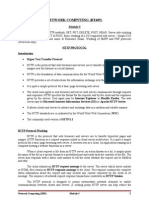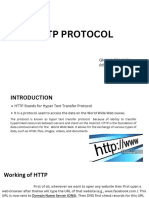HTTP Protocol
Uploaded by
Srikrishna RamanHTTP Protocol
Uploaded by
Srikrishna RamanHTTP Protocol : An Overview
The Hypertext Transfer Protocol (HTTP) is an application-level protocol with the lightness and speed necessary for distributed, collaborative, hypermedia information systems. It is a generic, stateless, objectoriented protocol which can be used for many tasks, such as name servers and distributed object management systems, through extension of its request methods (commands). A feature of HTTP is the typing of data representation, allowing systems to be built independently of the data being transferred. The HTTP is based on a request/response paradigm. A client establishes a connection with a server and sends a request to the server in the form of a request method, URL, and protocol version, followed by a MIME-like message containing request modifiers, client information, and possible body content. The server responds with a status line, including the message's protocol version and a success or error code, followed by a MIME-like message containing server information, entity maintain information, and possible body content. WebNMS supports the development of HTTP agents which confirms to HTTP 1.0 and HTTP 1.1 version.
HTTP Basics
HTTP stands for Hypertext Transfer Protocol. It's the network protocol used to deliver virtually all files and other data (collectively called resources) on the World Wide Web, whether they're HTML files, image files, query results, or anything else. Usually, HTTP takes place through TCP/IP sockets. A browser is an HTTP client because it sends requests to an HTTP server (Web server), which then sends responses back to the client. The standard (and default) port for HTTP servers to listen on is 80, though they can use any port. HTTP is used to transmit resources, not just files. A resource is some chunk of information that can be identified by a URL (Uniform Resource Locator). The most common kind of resource is a file, but a resource may also be a dynamically-generated query result, the output of a CGI script, a document that is available in several languages, or something else.
Structure of HTTP Transaction
Like most network protocols, HTTP uses the client-server model. An HTTP client opens a connection and sends a request message to an HTTP server; the server then returns a response message, usually containing the resource that was requested. After delivering the response, the server closes the connection (making HTTP a stateless protocol, i.e., not maintaining any connection information between transactions). The format of the request and response messages is similar and English-oriented. Both kinds of messages consist of: an initial line, zero or more header lines, a blank line (i.e., a CRLF by itself), and an optional message body (e.g., a file, or query data, or query output). In other words, the format of an HTTP message is <initial line, different for request vs. response> Header1: value1 Header2: value2
Header3: value3 <optional message body goes here, like file contents or query data; it can be many lines long, or even binary data $&*%@!^$@> Initial lines and headers should end in CRLF, though you should gracefully handle lines ending in just LF. (More exactly, CR and LF here mean ASCII values 13 and 10, even though some platforms may use different characters.)
HTTP Methods
A request line has three parts, separated by spaces: a method name, the local path of the requested resource, and the version of HTTP being used. There are three HTTP Methods, namely GET, HEAD, and POST.
The GET Method
GET is the most common HTTP method; it says "give me this resource". Other Method names are always in uppercase. The GET method can also be used to submit forms. The form data are URL-encoded and appended to the request URL.
The HEAD Method
A HEAD request is just like a GET request, except it asks the server to return the response headers only, and not the actual resource (i.e., no message body). This is useful to check characteristics of a resource without actually downloading it, thus saving bandwidth. Use HEAD when you don't actually need a file's contents. The response to a HEAD request must never contain a message body, but just the status line and headers.
The POST Method
POST request is used to send data to be processed to the server in some way, such as using a CGI script. A POST request is different from a GET request in the following ways: There's a block of data sent with the request, in the message body. There are usually extra headers to describe this message body, like Content-Type: and Content-Length:. The request URL is not a resource to retrieve; it's usually a program to handle the data you're sending.
The HTTP response is normally program output, not a static file. The most common use of POST, by far, is to submit HTML form data to CGI scripts. In this case, the Content-Type: header is usually application/x-www-form-url encoded, and the Content-Length: header gives the length of the URLencoded form data. You can use a POST request to send whatever data you want, not just form submissions. Just make sure the sender and the receiving program agree on the format
You might also like
- Network Computing (Rt605) : Hyper Text Transfer ProtocolNo ratings yetNetwork Computing (Rt605) : Hyper Text Transfer Protocol19 pages
- A Practical Guide To Writing Clients and Servers: Go To Table of Contents Go To Footnotes Go To Other TutorialsNo ratings yetA Practical Guide To Writing Clients and Servers: Go To Table of Contents Go To Footnotes Go To Other Tutorials18 pages
- Interaction Between Client and Server: INF 335 Web Server TechnologiesNo ratings yetInteraction Between Client and Server: INF 335 Web Server Technologies43 pages
- Hypertext Transfer Protocol (HTTP) : Shweta DubeyNo ratings yetHypertext Transfer Protocol (HTTP) : Shweta Dubey15 pages
- World Wide Web - Part I: Indian Institute of Technology KharagpurNo ratings yetWorld Wide Web - Part I: Indian Institute of Technology Kharagpur23 pages
- World Wide Web: Uniform Resource Locators (URL)No ratings yetWorld Wide Web: Uniform Resource Locators (URL)5 pages
- Web Security (CAT-309) - Unit 1 Lecture 3No ratings yetWeb Security (CAT-309) - Unit 1 Lecture 313 pages
- EContent 11 2023 03 01 18 07 21 02Unit2ApplicationLayerpptx 2023 01 31 08 52 45No ratings yetEContent 11 2023 03 01 18 07 21 02Unit2ApplicationLayerpptx 2023 01 31 08 52 4583 pages
- Protocol: By: Manish Kumar Pilani (Rajasthan) IndiaNo ratings yetProtocol: By: Manish Kumar Pilani (Rajasthan) India42 pages
- Evaluation of Some SMTP Testing, Email Verification, Header Analysis, SSL Checkers, Email Delivery, Email Forwarding and WordPress Email ToolsFrom EverandEvaluation of Some SMTP Testing, Email Verification, Header Analysis, SSL Checkers, Email Delivery, Email Forwarding and WordPress Email ToolsNo ratings yet
- Configuring The DHCP Server For Huawei FirewallNo ratings yetConfiguring The DHCP Server For Huawei Firewall10 pages
- Siemens Enterprise Communications: Product Name: Openstage SIP Product Version: V2 Software Release Version: V2R2.48.0No ratings yetSiemens Enterprise Communications: Product Name: Openstage SIP Product Version: V2 Software Release Version: V2R2.48.025 pages
- Introduction To Web Penetration TestingNo ratings yetIntroduction To Web Penetration Testing60 pages
- COMP2330 Data Communications and Networking: Dr. Chu XiaowenNo ratings yetCOMP2330 Data Communications and Networking: Dr. Chu Xiaowen8 pages
- HowTo Configure VoIP Survival With BroadsoftNo ratings yetHowTo Configure VoIP Survival With Broadsoft6 pages
- Information Security Management LecturesNo ratings yetInformation Security Management Lectures175 pages
- 2023 Al SFT Part I MCQ Paper Sinhala Medium Alevelapi PDFNo ratings yet2023 Al SFT Part I MCQ Paper Sinhala Medium Alevelapi PDF8 pages

























































































